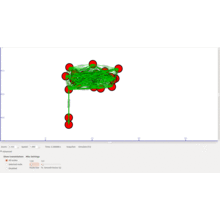How to Begin Implement Network Communication Range in NS3
To implement a Network Communication Range using NS3, we can adhere to these detailed steps:
Steps to Begin Implement Network Communication Range in NS3
- Understand the Concept
In NS3, network communication range is computed by:
- The nodes’ transmit power.
- The propagation loss model designed for replicating the environmental impacts on signal strength.
- The receiver sensitivity that calculates the minimum energy level entailed for effective reception.
- Set Up Your Environment
- We can install and download ns3 on the machine.
- Make acquainted regarding simple ns3 scripting, which is specifically utilized in C++ or Python according to the favoured programming language.
- Choose and Configure a Propagation Model
Describe how the signal reduces with distance by propagation model. Followings are generally utilized propagation models:
- Friis Propagation Loss Model: It is appropriate for free-space environments.
- Log-Distance Propagation Loss Model: Integrates logarithmic path loss.
- Two-Ray Ground Propagation Loss Model: Deliberates both straight and reflected rays.
- ITU-R Propagation Loss Model: It supports to replicate urban, suburban, or rural scenarios.
Example for Friis in C++:
Ptr<YansWifiChannel> wifiChannel = CreateObject<YansWifiChannel> ();
Ptr<YansWifiPhy> wifiPhy = CreateObject<YansWifiPhy> ();
wifiPhy->SetChannel(wifiChannel);
Ptr<FriisPropagationLossModel> lossModel = CreateObject<FriisPropagationLossModel> ();
wifiChannel->SetPropagationLossModel(lossModel);
- Set Transmit Power and Sensitivity
In the physical layer, specify the transmission power and receiver sensitivity:
wifiPhy->Set(“TxPowerStart”, DoubleValue(20)); // Start power in dBm
wifiPhy->Set(“TxPowerEnd”, DoubleValue(20)); // End power in dBm
wifiPhy->Set(“RxSensitivity”, DoubleValue(-80)); // Sensitivity in dBm
- Create and Position Nodes
Locate the nodes in the simulation area for analyzing the range of interaction:
NodeContainer nodes;
nodes.Create(2);
MobilityHelper mobility;
mobility.SetPositionAllocator(“ns3::GridPositionAllocator”,
“MinX”, DoubleValue(0.0),
“MinY”, DoubleValue(0.0),
“DeltaX”, DoubleValue(50.0), // Distance between nodes
“DeltaY”, DoubleValue(0.0),
“GridWidth”, UintegerValue(3),
“LayoutType”, StringValue(“RowFirst”));
mobility.SetMobilityModel(“ns3::ConstantPositionMobilityModel”);
mobility.Install(nodes);
- Install Network Stack
We shall install a Wi-Fi network stack or any other protocol to replicate:
WifiHelper wifi;
wifi.SetStandard(WIFI_PHY_STANDARD_80211b);
WifiMacHelper mac;
Ssid ssid = Ssid(“network-range-test”);
mac.SetType(“ns3::StaWifiMac”, “Ssid”, SsidValue(ssid), “ActiveProbing”, BooleanValue(false));
NetDeviceContainer devices = wifi.Install(wifiPhy, mac, nodes);
- Test Communication
Experiment the interaction among nodes utilising an application such as UDP or TCP. For example, we will need to configure a UDP server and client:
UdpEchoServerHelper echoServer(9);
ApplicationContainer serverApps = echoServer.Install(nodes.Get(0));
serverApps.Start(Seconds(1.0));
serverApps.Stop(Seconds(10.0));
UdpEchoClientHelper echoClient(Address(InetSocketAddress(Ipv4Address(“10.1.1.1”), 9)), 9);
echoClient.SetAttribute(“MaxPackets”, UintegerValue(1));
echoClient.SetAttribute(“Interval”, TimeValue(Seconds(1.0)));
echoClient.SetAttribute(“PacketSize”, UintegerValue(1024));
ApplicationContainer clientApps = echoClient.Install(nodes.Get(1));
clientApps.Start(Seconds(2.0));
clientApps.Stop(Seconds(10.0));
- Analyze Results
- Execute the simulation and then monitor whether interaction achieves on various distances.
- Fine-tune metrics such as TxPower, RxSensitivity, and PropagationLossModel for comprehending the influence over communication range.
- Visualize
We can envision the network using NetAnim or transfer the outcomes into external tools such as MATLAB which is used for visualization:
AnimationInterface anim(“network_range.xml”);
- Iterate and Optimize
Test with:
- Various propagation models.
- Modifying TxPower and RxSensitivity.
- Establishing obstacles to leverage more advanced models such as Building Module.
We have presented the implementation of Network Communication Range in a step-by-step manner with practical examples using NS3 environment. We are ready to enrich it further for advanced exploration.

 Click Here to watch our latest output video using NS3 simulator
Click Here to watch our latest output video using NS3 simulator  Click Here to watch our latest projects screenshots using NS3 simulator
Click Here to watch our latest projects screenshots using NS3 simulator